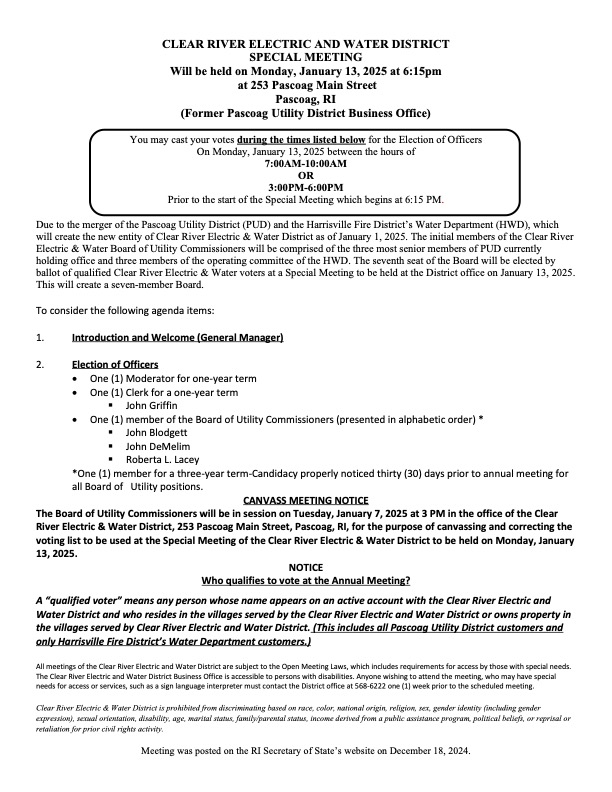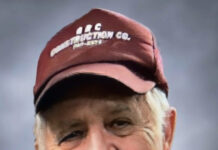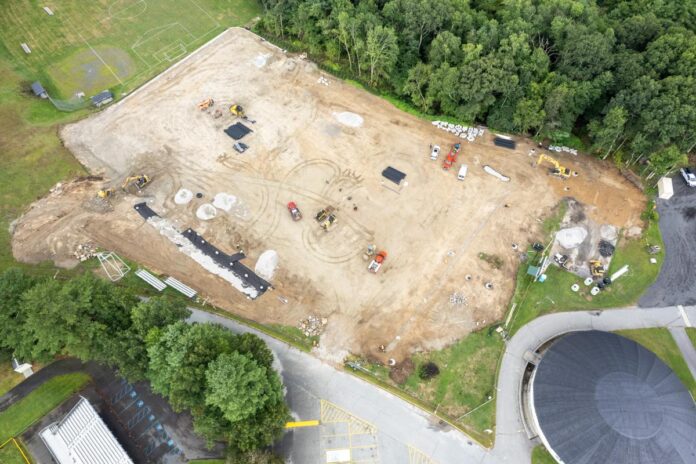BURRILLVILLE – With hearings on a preliminary injunction that has held up efforts to install a new synthetic turf field at Burrillville High School now largely concluded, Town Manager Michael Wood said that Burrillville has spent more than $200,000 on research and litigation costs since questions regarding the project were raised last May.
Wood notes that final briefs were filed in Providence County Superior Court on Monday, Jan. 6, and a decision from Associate Justice Melissa Darigan is expected by the end of the month or in early February.
The suit, filed in September by resident Roberta Lacey, is focused on concerns about PFAS, or per- and polyfluoroalkyl substances, known as “forever chemicals,” and the field’s location over an aquifer. Represented by Attorneys Michelle Hawes and Marisa Desautel of Desautel Browning Law, Lacey has charged that the field contains chemicals that have the potential to contaminate the town water supply and that the project should have required Zoning Board approval.

Part of a larger effort to upgrade school athletic facilities, the field is just one element of improvements that included lighting, an ADA-accessible viewing plaza, a six-foot-wide walking path and a 1,000-seat grandstand. For the field itself, the town signed a contract with provider FieldTurf USA in December of 2023 to design, manufacture, and install the turf.
With other work complete, installation was scheduled for October before a temporary restraining order halted the project.
Testing ordered by the town has shown only trace chemicals in the proposed field materials, and concluded the installation poses no threat to human health. But Lacey and other opponents have questioned the adequacy of testing methods, and laid out concerns and objections ultimately leading to the litigation.
Attorneys Anthony DeSisto and Town Solicitor William Dimitri recently filed a counterclaim on behalf of the town noting that Lacey did not file her lawsuit until after construction of the field had begun, and that the “belated,” litigation “harms Burrillville taxpayers by delaying the completion of the project.”
Current court proceedings are expected to determine if a restraining order on the work should be lifted.
“Regardless of the outcome of the current court proceeding, there is still the probability of a trial later on which will completely blow up the budget and drain the town’s reserve accounts,” noted Wood in an update on the suit released this week. “$200,000 (projected) of taxpayer reserves is now gone and it looks like there will be much more to come, so please don’t complain or criticize about school funding, roads not being improved or other important projects or community assistance not being funded if you’re supporting the lawsuit against the town.”
The town has published a webpage with information on the field project, which has recently been used for updates on the litigation.
The complete update from the town can be found on the Burrillville NOW page here.








The Town leadership should stop fighting the taxpayers that voted for them and stop wasting money on something that may be hazardous (my opinion is to err on the side of caution).
Each cent spent fighting this going forward is a cent wasted. Just stop!
Plant real grass…..
All comments from those supporting efforts to stop the project from going forward with the installation of toxic, non-sustainable, non-recyclable, environmentally harmful plastic grass that is also being linked to major health issues are well said and appreciated by a fellow advocate who HATES plastic grass! Hoping your group is successful in your efforts. Will be a wake-up call for the rest of the country. Can’t wait!!!!
Andrea
Well said and applauded by another fellow advocate who went through the MBTE crisis. Will they ever learn??
Lots of Chicken Littles commenting here. The sky is falling!
No surprise here about the town’s dysfunction. Had they allowed us access to Bronco Hwy for a small 10,000 s.f. retail development last year, our client would be open and paying taxes now. Planning and zoning did not realize that the Nasonville Redevelopment Agency knew more about the zoning regulations than the planner until the redevelopment agency came out in opposition of our application.
The project went from full support of the planning commission in November ’23 to a unanimous decision to deny our approval in March 2024. The citizenry should take a hard look at the people running the town if they really want changes.
The recent announcement by the EPA adding nine more PFAS chemicals to the Toxics Release Inventory underscores the growing evidence of the dangers posed by these toxic substances and should be wakeup call to those advocating for this project. Yet, Burrillville’s leadership remains fixated on pushing forward a $5 million artificial turf project riddled with PFAS, while blaming residents for questioning the town’s reckless spending and poor management. The tone of recent town communications is not only dismissive but also indicative of a refusal to take responsibility. Blaming citizens for infrastructure neglect while funneling millions into an artificial turf field that the majority of town residents don’t want is an alarming misuse of funds.
I agree with the two commenters above (Diana and Dianne). Moving to durable, high performing real grass, with state of the art grass types tailored for the area, plus intelligent installation and maintenance is much healthier, safer AND always more cost-effective than doubling down on rolling out a hot, chemical-laden plastic carpet which is so much more expensive up front and then has repeated removal, disposal and replacement costs ($500,000 or more each time) that grass never has. Studies have also shown synturf sheds macro and microplastics into air, soil and water, which will likely contaminate the aquifer and eventually lead to a tsunami of clean-up and possibly litigation costs.
Town = egg on face. Please don’t keep wasting out tax money. Should’ve done more research on this up front. The consequences and controversies were well known in 2018-2020.
As a tax payer in the town of Burrillville all I see is a waste of the tax dollars .. these are kids playing football this is not the NFL .
Maybe if the town didn’t spend are tax dollar on these over priced projects just to make a few people happy they could lower taxes making everyone happy.
Put aside the controversy of turf field safety for one second, though studies and tests prove they are harmful in so many ways. The arrogance of the Town Council and Town Administrator blaming the costs on concerned citizens and not taking any responsibility at all is laughable and would be enough to vote them all out in any other times. All the council needed to do once they saw the abundant opposition is to table it and restudy by independent testers. Which has been done by the opposition by the way. I just hope voters remember in 2026!
Not only are these fields toxic from the PFAS , they are also loaded with endocrine disrupting chemicals and known human carcinogens.
And: They get lethally hot – 30-50 degrees above ambient temperatures on warm sunny days. EHS (exertional heat stroke) is the number one cause of death of high school football players, and things are only getting hotter for more days per year and more hours per day.
And: The fields are also terribly expensive- $600k to $1.2M. They must be replaced every 8 to 12 years, plus costs include the maintenance needed to keep the fields safe. They always look nice and green, but unless they are groomed and the infill is constantly replenished (especially after major rain events, wind etc.) they do not meet safety standards for impact. Is that cleaning and decompaction and grooming and additional infill clearly in the budget? How often will the safety testing be conducted and is that company in a standing relationship with the field seller?
And: They have dramatically higher injury rates especially to lower extremities: ACL, knee, ankle, foot, turf toe, as shown by many studies, including two multi year peer reviewed, published scientific studies run by the NFL on all 32 teams. Don’t forget concussions and joint injury from impact on the extra heart surface.
(Synthetic turf industry acknowledges both heat and hardness are a problem)
And then there is disposal. Used fields are not – NOT – being recycled anywhere in the US. Maybe some of the tire crumb info is getting reused. Maybe some small portion of the plastic “grass“carpet is going to batting cages or dog runs. But with over 20,000 fields around the US… How many dog runs do you have exactly?Who wants your used 400 tons of mixed toxic plastic waste? It’s bulk and heavy, so expensive to move. As a result it often gets “stored“ or dumped. Does that align with anyone’s sustainability goals?
$200k now or millions later to deal with contaminated aquifer…and millions more for related litigation and health care costs.